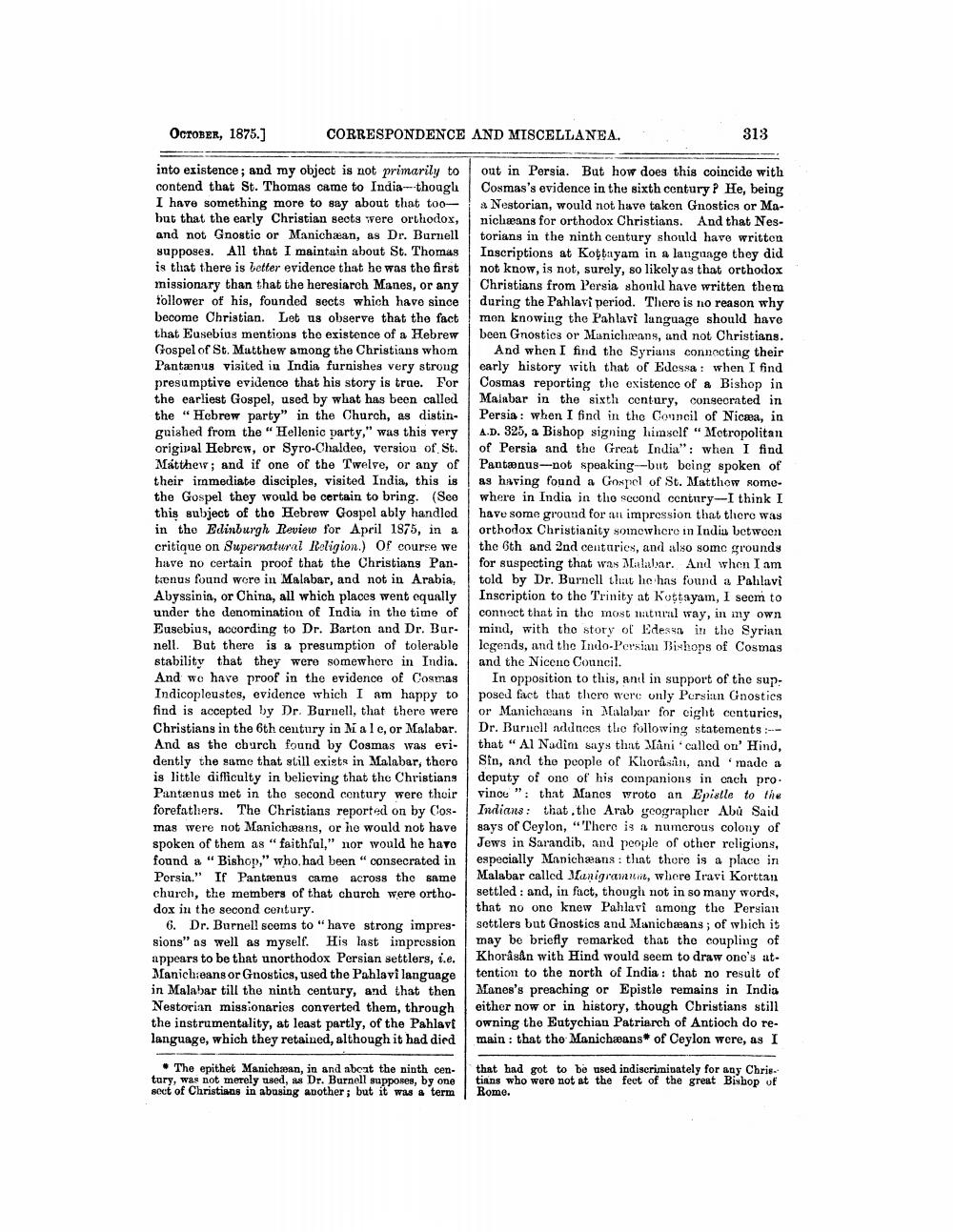________________
OCTOBER, 1875.)
CORRESPONDENCE AND MISCELLANEA.
313
-
-
into existence; and my object is not primarily to contend that St. Thomas came to India-though I have something more to say about that toobut that the early Christian sects were orthodox, and not Gnostic or Manichæan, as Dr. Burnell supposes. All that I maintain about St. Thomas is that there is better evidence that he was the first missionary than that the heresiarch Manes, or any follower of his, founded sects which have since become Christian. Let us observe that the fact that Eusebius mentions the existence of a Hebrew Gospel of St. Matthew among the Christians whom Pantanus visited in India furnishes very strong presumptive evidence that his story is true. For the earliest Gospel, used by what has been called the "Hebrew party" in the Church, as distin- guished from the "Hellenic party," was this very origival Hebrew, or Syro-Chaldeo, versiou of St. Matthew; and if one of the Twelve, or any of their immediate disciples, visited India, this is the Gospel they would be certain to bring. (Sco this subject of the Hebrew Gospel ably handlod in the Edinburgh Review for April 1875, in a critique on Supernatural Religion.) Of course we have no certain proof that the Christians Panteenus found were in Malabar, and not in Arabia, Abyssinin, or China, all which places went equally under the denomination of India in the time of Eusebius, according to Dr. Barton and Dr. Bur. nell. But there is a presumption of tolerable stability that they were somewhere in India. And we have proof in the evidence of Cogmas Indicopleustes, evidence which I am happy to find is accepted by Dr. Burnell, that there were Christians in the 6th century in Male, or Malabar. And as the church found by Cosmas was eridently the same that still exists in Malabar, there is little difficulty in believing that the Christians Pantanus met in the second century were their forefathers. The Christians reported on by Cos. mas were not Manichæans, or he would not have spoken of them as "faithful," nor would he havo found a "Bishop," who had been consecrated in Persia." If Pantænus came across the same church, the members of that church were orthodox in the second century.
6. Dr. Burnell seems to "have strong impres. sions" as well as myself. His last impression appears to be that unorthodox Persian settlers, i.e. Manicheans or Gnostics, used the Pahlavi language in Malabar till the ninth century, and that then Nestorian missionaries converted them, through the instrumentality, at least partly, of the Pahlavi language, which they retained, although it had died
out in Persia. But how does this coincide with Cosmas's evidence in the sixth century? He, being # Nestorian, would not have taken Gnostics or Manichæans for orthodox Christians. And that Nestorians in the ninth century should have written Inscriptions at Kottayam in a language they did not know, is not, surely, so likely as that orthodox Christians from Persia shonld have written thema during the Pahlavi period. There is no reason why mon knowing the Pahlavi language should have been Gnostics or Manichrans, and not Christians.
And when I find the Syrians connecting their early history with that of Edessa: when I find Cosmas reporting the existence of a Bishop in Malabar in the sixth century, congeorated in Persia: when I find in the Council of Nicæa, in A.D. 325, a Bishop signing himself "Metropolitan of Persia and the Great India": when I find Pantanus-not speaking-but being spoken of as having found a Gospel of St. Matthew somewhere in India in the second century-I think I have some ground for at impression that there was orthodox Christianity somewhere in India between the 6th and 2nd centuries, and also some grounds for suspecting that was Malabar. And when I am told by Dr. Burnell that he has found a Pahlavi Inscription to the Trinity at Kottayam, I seem to connect that in the most natural way, in any own mind, with the story of Edese in the Syrian legendy, and the Indo-Persian Bishops of Cosmas and the Nicene Council.
In opposition to this, anil in support of the supposed fact that there were only Persian Gnostics or Manichæans in Malabar for cight centuries, Dr. Burnell audaces the following statements:-- that "Al Nadim says that Manicalled on' Hind, Sin, and the people of Khorasan, and made a deputy of one of his companions in onch pro. vincu": that Mancs wroto an Epislle to the Indians: that the Arab geographer Abu Said says of Ceylon, "There is a numerous colony of Jews in Sarandib, and people of other religions, especially Manichæans: that there is a place in Malabar called Manigramit, where Iravi Korttan settled : and, in fact, though not in so many words, that no one knew Pahlavi among the Persian settlers but Gnostics and Manichæans; of which it may be briefly remarked that the coupling of Khorasan with Hind would seem to draw one's at. tention to the north of India: that no result of Manes's preaching or Epistle remains in India either now or in history, though Christians still owning the Eutychian Patriarch of Antioch do remain: that tho Manichæans of Ceylon were, as I
• The epithet Manichæan, in and about the ninth cen- that had got to be used indiscriminately for any Chris tary, was not merely used, as Dr. Burnell suppores, by onetians who were not at the feet of the great Bishop of sect of Christians in abusing another; but it was a term Rome.




